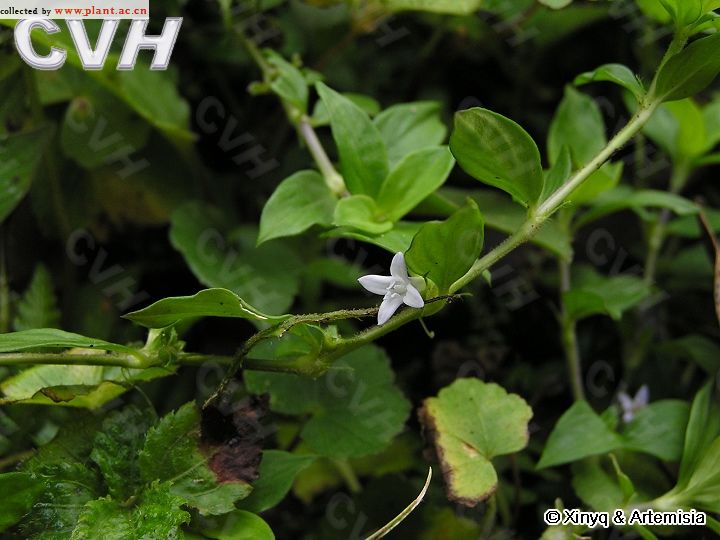金毛耳草Hedyotis chrysotricha (Palib.) Merr.
金毛耳草Hedyotis chrysotricha (Palib.) Merr.
9. 金毛耳草(中国高等植物图鉴)石打穿(中药临床手册)
Hedyotis chrysotricha (Palib.) Merr. in Lingnan Sci. Journ. 7: 322. 1929; 中国高等植物图鉴4: 214, 图5842. 1975; 云南种子植物名录, 下册: 1254. 1984; 新华本草纲要2: 442. 1991; 横断山区维管植物, 下册: 1886. 1994. ——Anotis chrysotricha Palib. in Bull. Herb. Boiss. ser. 2, 6: 20. 1906; Dunn & Tutch. in Kew Bull. Misc. Inf. Add. Ser. 10: 129. 1912. ——Oldenlandia chrysotricha (Palib.) Chun in Sunyatsenia 1: 311. 1934; Hand. -Mazz. Symb. Sin. 7 (4): 1015. 1936.
多年生披散草本,高约30厘米,基部木质,被金黄色硬毛。叶对生,具短柄,薄纸质,阔披针形、椭圆形或卵形,长20-28毫米,宽10-12毫米,顶端短尖或凸尖,基部楔形或阔楔形,上面疏被短硬毛,下面被浓密黄色绒毛,脉上被毛更密;侧脉每边2-3条,极纤细,仅在下面明显;叶柄长1-3毫米;托叶短合生,上部长渐尖,边缘具疏小齿,被疏柔毛。聚伞花序腋生,有花1-3朵,被金黄色疏柔毛,近无梗;花萼被柔毛,萼管近球形,长约13毫米,萼檐裂片披针形,比管长;花冠白或紫色,漏斗形,长5-6毫米,外面被疏柔毛或近无毛,里面有髯毛,上部深裂,裂片线状长圆形,顶端渐尖,与冠管等长或略短;雄蕊内藏,花丝极短或缺;花柱中部有髯毛,柱头棒形,2裂。果近球形,直径约2毫米,被扩展硬毛,宿存萼檐裂片长1-1.5毫米,成熟时不开裂,内有种子数粒。花期几乎全年。
产于广东、广西、福建、江西、江苏、浙江、湖北、湖南、安徽、贵州、云南、台湾等省区;生于山谷杂木林下或山坡灌木丛中,极常见。模式标本采自福建省,具体地点不详。
《Flora of China》 Vol. 19 (2011)
Hedyotis chrysotricha (Palibin) Merrill Lingnan Sci. J. 7: 322. 1931.
金毛耳草 jin mao er cao
Anotis chrysotricha Palibin, Bull. Herb. Boissier, sér. 2, 6: 20. 1906; Oldenlandia chrysotricha (Palibin) Chun.
Herbs, perennial or perhaps annual, procumbent, usually regularly rooting at nodes, to 40 cm; stems weakly 4-angled, flattened, or terete, sometimes 2-sulcate, moderately to densely hirtellous to pilosulous at least along grooves, sometimes glabrescent, trichomes often drying yellowed. Leaves subsessile to petiolate; petiole 1-3 mm, moderately to densely pilosulous to hirtellous; blade drying thinly papery, lanceolate, elliptic, or ovate, 0.8-3.2 × 0.5-1.4 cm, adaxially sparsely hirtellous, hispidulous, or scaberulous at least along margins, abaxially sparsely to densely hirtellous or pilosulous with pubescence denser along principal veins or sometimes glabrous (e.g., Tsang 20859, MO!), base cuneate or obtuse, apex obtuse to acute or shortly acuminate; secondary veins 2 or 3 pairs; stipules fused to petiole bases, triangular, 1-2 mm, moderately to densely puberulent to hirtellous, with 1-3 linear lobes or bristles 1.5-3.5 mm, these sometimes glandular and/or bifid at apex. Inflorescences axillary, congested-cymose to fasciculate, 3-10 mm in diam., (1 or)2-5-flowered in each axil, moderately to densely pilosulous, sessile or subsessile; bracts linear, lanceolate, or narrowly elliptic, 0.5-4 mm; pedicels to 4 mm. Flowers subsessile to pedicellate, distylous. Calyx sparsely to densely hirtellous; hypanthium portion subglobose to obconic, ca. 1 mm; limb lobed essentially to base; lobes lanceolate to triangular, ca. 2 mm, usually ciliolate to ciliate. Corolla white or purple, funnelform, outside pilosulous to glabrous; tube 2.5-4 mm, pubescent inside; lobes linear-oblong to triangular, 2.5-3 mm. Anthers exserted or included, 1-1.2 mm. Stigma exserted or included, 1-1.2 mm. Fruit indehiscent, subglobose to ovoid, 1.5-2 × 2-2.5 mm, with calyx lobes to 3 mm; seeds several. Fl. and fr. year-round.
Broad-leaved forests in valleys, thickets on mountain slopes; 100-900 m. Anhui, Fujian, Guangdong, Guangxi, Guizhou, Hainan, Hubei, Hunan, Jiangsu, Jiangxi, Taiwan, Yunnan, Zhejiang [Japan, ?Philippines].
别名:爬岩草;窝仰密;朴地蜈蚣;爬岩菜;铺地蜈蚣;地蜈蚣草;地蜈蚣;石打穿;白头走马仔;田铜锤;拖地莲;蜈蚣草;细种节节花;小八步拿;黄毛耳草;伤口草;伤口药;
科名:茜草科 Rubiaceae
属名:耳草属 Hedyotis

9. 金毛耳草(中国高等植物图鉴)石打穿(中药临床手册)
Hedyotis chrysotricha (Palib.) Merr. in Lingnan Sci. Journ. 7: 322. 1929; 中国高等植物图鉴4: 214, 图5842. 1975; 云南种子植物名录, 下册: 1254. 1984; 新华本草纲要2: 442. 1991; 横断山区维管植物, 下册: 1886. 1994. ——Anotis chrysotricha Palib. in Bull. Herb. Boiss. ser. 2, 6: 20. 1906; Dunn & Tutch. in Kew Bull. Misc. Inf. Add. Ser. 10: 129. 1912. ——Oldenlandia chrysotricha (Palib.) Chun in Sunyatsenia 1: 311. 1934; Hand. -Mazz. Symb. Sin. 7 (4): 1015. 1936.
多年生披散草本,高约30厘米,基部木质,被金黄色硬毛。叶对生,具短柄,薄纸质,阔披针形、椭圆形或卵形,长20-28毫米,宽10-12毫米,顶端短尖或凸尖,基部楔形或阔楔形,上面疏被短硬毛,下面被浓密黄色绒毛,脉上被毛更密;侧脉每边2-3条,极纤细,仅在下面明显;叶柄长1-3毫米;托叶短合生,上部长渐尖,边缘具疏小齿,被疏柔毛。聚伞花序腋生,有花1-3朵,被金黄色疏柔毛,近无梗;花萼被柔毛,萼管近球形,长约13毫米,萼檐裂片披针形,比管长;花冠白或紫色,漏斗形,长5-6毫米,外面被疏柔毛或近无毛,里面有髯毛,上部深裂,裂片线状长圆形,顶端渐尖,与冠管等长或略短;雄蕊内藏,花丝极短或缺;花柱中部有髯毛,柱头棒形,2裂。果近球形,直径约2毫米,被扩展硬毛,宿存萼檐裂片长1-1.5毫米,成熟时不开裂,内有种子数粒。花期几乎全年。
产于广东、广西、福建、江西、江苏、浙江、湖北、湖南、安徽、贵州、云南、台湾等省区;生于山谷杂木林下或山坡灌木丛中,极常见。模式标本采自福建省,具体地点不详。
《Flora of China》 Vol. 19 (2011)
Hedyotis chrysotricha (Palibin) Merrill Lingnan Sci. J. 7: 322. 1931.
金毛耳草 jin mao er cao
Anotis chrysotricha Palibin, Bull. Herb. Boissier, sér. 2, 6: 20. 1906; Oldenlandia chrysotricha (Palibin) Chun.
Herbs, perennial or perhaps annual, procumbent, usually regularly rooting at nodes, to 40 cm; stems weakly 4-angled, flattened, or terete, sometimes 2-sulcate, moderately to densely hirtellous to pilosulous at least along grooves, sometimes glabrescent, trichomes often drying yellowed. Leaves subsessile to petiolate; petiole 1-3 mm, moderately to densely pilosulous to hirtellous; blade drying thinly papery, lanceolate, elliptic, or ovate, 0.8-3.2 × 0.5-1.4 cm, adaxially sparsely hirtellous, hispidulous, or scaberulous at least along margins, abaxially sparsely to densely hirtellous or pilosulous with pubescence denser along principal veins or sometimes glabrous (e.g., Tsang 20859, MO!), base cuneate or obtuse, apex obtuse to acute or shortly acuminate; secondary veins 2 or 3 pairs; stipules fused to petiole bases, triangular, 1-2 mm, moderately to densely puberulent to hirtellous, with 1-3 linear lobes or bristles 1.5-3.5 mm, these sometimes glandular and/or bifid at apex. Inflorescences axillary, congested-cymose to fasciculate, 3-10 mm in diam., (1 or)2-5-flowered in each axil, moderately to densely pilosulous, sessile or subsessile; bracts linear, lanceolate, or narrowly elliptic, 0.5-4 mm; pedicels to 4 mm. Flowers subsessile to pedicellate, distylous. Calyx sparsely to densely hirtellous; hypanthium portion subglobose to obconic, ca. 1 mm; limb lobed essentially to base; lobes lanceolate to triangular, ca. 2 mm, usually ciliolate to ciliate. Corolla white or purple, funnelform, outside pilosulous to glabrous; tube 2.5-4 mm, pubescent inside; lobes linear-oblong to triangular, 2.5-3 mm. Anthers exserted or included, 1-1.2 mm. Stigma exserted or included, 1-1.2 mm. Fruit indehiscent, subglobose to ovoid, 1.5-2 × 2-2.5 mm, with calyx lobes to 3 mm; seeds several. Fl. and fr. year-round.
Broad-leaved forests in valleys, thickets on mountain slopes; 100-900 m. Anhui, Fujian, Guangdong, Guangxi, Guizhou, Hainan, Hubei, Hunan, Jiangsu, Jiangxi, Taiwan, Yunnan, Zhejiang [Japan, ?Philippines].

